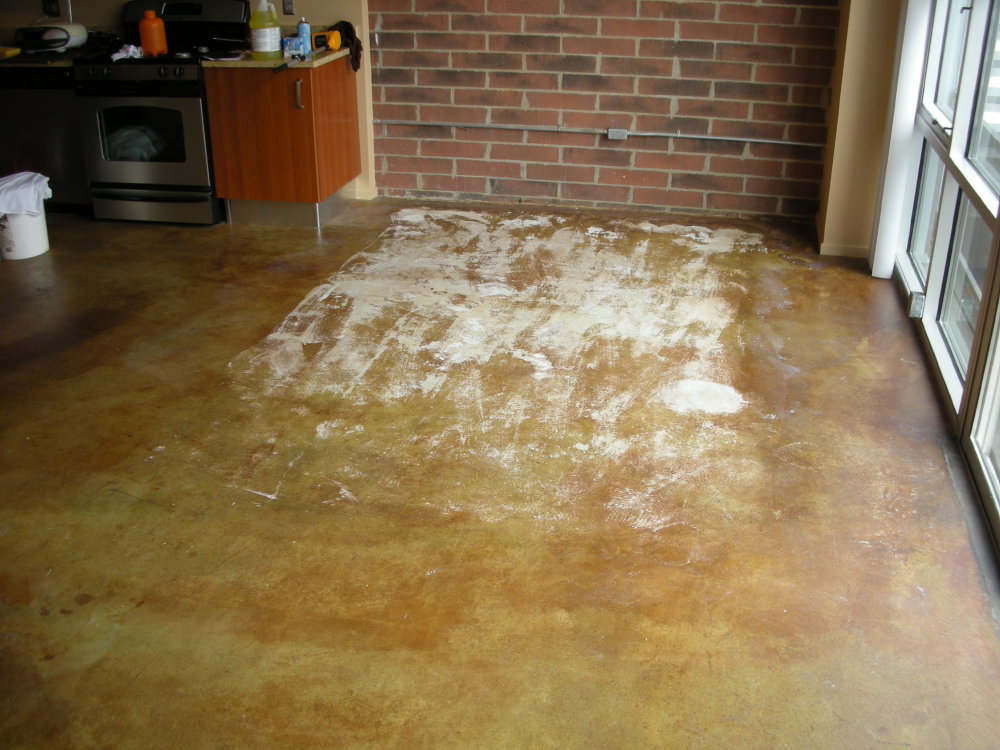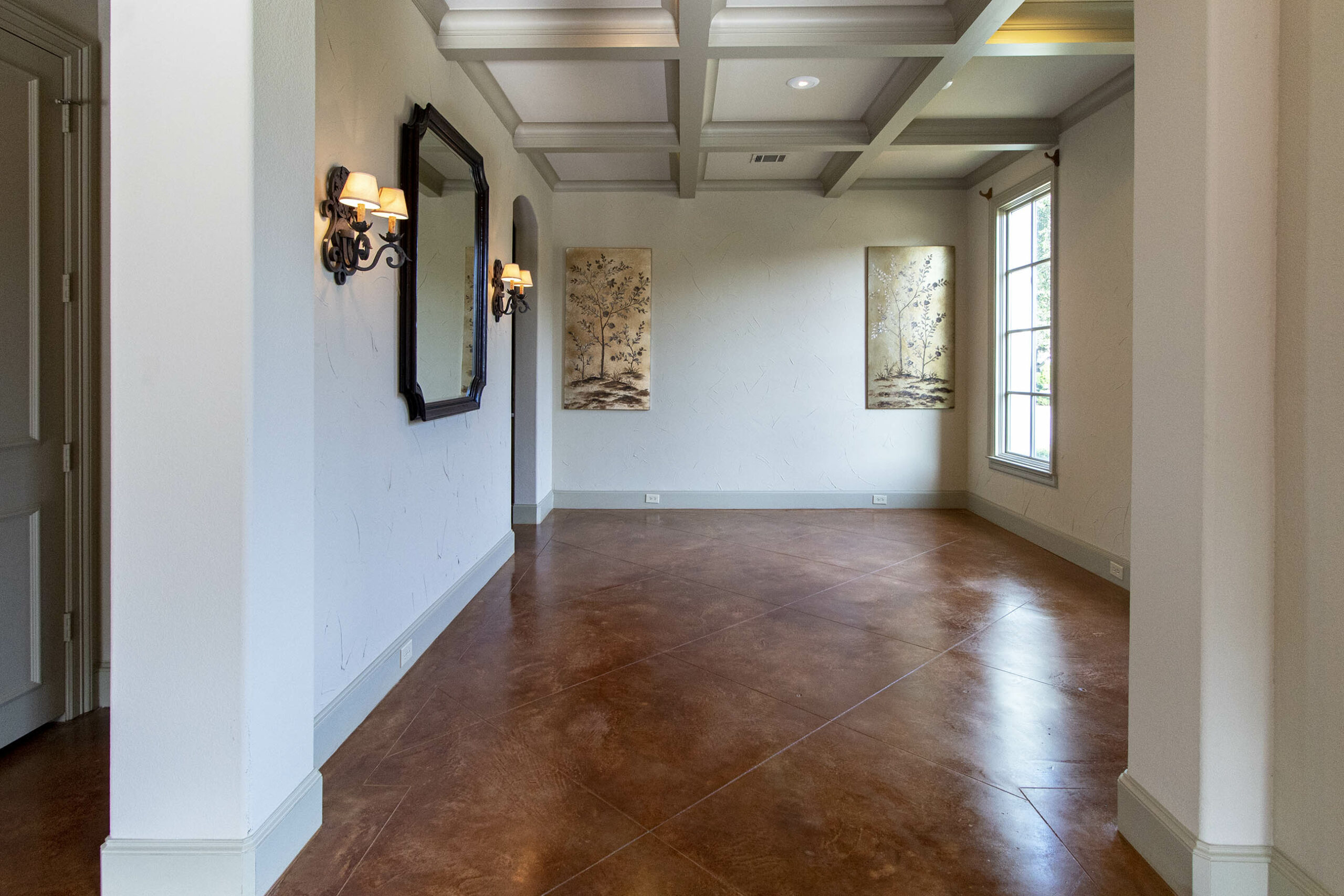The detailed process of staining stained concrete floors austin texas
All Concerning Stained Concrete: A Comprehensive Guide to Its Benefits and Applications
Stained concrete has actually become a popular selection for both residential and commercial rooms. Its capability to incorporate visual appeal with functionality makes it an interesting choice. Various staining methods use a variety of colors and coatings, permitting personalization. However, the advantages extend past appearance. Understanding its applications and maintenance demands is essential for any person considering this versatile material. The nuances of stained concrete invite further expedition.
What Is Stained Concrete?

Staining can be used to various surface areas, consisting of floorings, driveways, and patios, making it a versatile alternative for both interior and outside rooms. The treatment can achieve an array of appearances, from earthy tones to strong, contemporary styles. Unlike paint, stained concrete keeps its appearance gradually, as it comes to be an essential component of the concrete itself. Overall, stained concrete works as a reliable method for transforming regular concrete right into aesthetically striking surface areas.
Advantages of Stained Concrete
Stained concrete deals substantial benefits, especially in aesthetic charm and longevity - Stained Concrete Floors Austin. Its dynamic colors and distinct patterns enhance the aesthetic appeal of any type of space, making it a popular choice for both domestic and business applications. Furthermore, the durability of stained concrete guarantees that it remains a practical investment gradually, withstanding deterioration
Visual Allure
One of one of the most engaging benefits of making use of stained concrete is its impressive aesthetic charm. Stained concrete offers a distinct and flexible look that can complement various layout styles, from modern-day to rustic. The mixture of dynamic colors and detailed patterns permits home owners and developers to produce customized surface areas that can improve the general ambiance of an area. Unlike traditional floor covering choices, stained concrete can resemble the look of natural rock or refined marble, supplying an upscale appearance without the connected costs. In addition, the glossy coating alternatives can mirror light, additional brightening interiors. This adaptability makes stained concrete a favored choice for both residential and commercial applications, where visual impact is vital.
Sturdiness and Longevity
The excellent visual qualities of stained concrete are enhanced by its impressive sturdiness and longevity - Stained Concrete Floors Austin. Stained concrete surfaces are immune to deterioration, making them ideal for high-traffic locations both inside your home and outdoors. Their robust nature implies they can hold up against rough weather, consisting of extreme temperatures, rainfall, and UV exposure, without significant deterioration. In enhancement, stained concrete requires marginal maintenance contrasted to other flooring choices, as it does not require frequent sealing or refinishing. This longevity not just lowers replacement costs but also adds to a lasting structure method. Generally, stained concrete gives an enduring solution that integrates aesthetic allure with practical benefits, ensuring its worth over time
Different Kinds Of Staining Methods
Various discoloration techniques can noticeably impact the aesthetic qualities of concrete surfaces. The 3 primary approaches consist of acid staining, which reacts chemically with the concrete, water-based staining, which provides a wider series of shades, and overlay staining alternatives that give a fresh surface. Each technique has one-of-a-kind features and applications that satisfy various design choices and task needs.
Acid Staining Method
How can house owners change simple concrete surface areas into aesthetically striking attributes? One reliable technique is acid staining, a popular strategy that improves the all-natural beauty of concrete. This procedure includes using an option of water, hydrochloric acid, and metallic salts to the concrete surface area. As the acid reacts with the lime existing in the concrete, it develops rich, variegated shades that appear like marble or rock. Acid staining is recognized for its longevity and resistance to fading, making it a durable selection for both interior and outside applications. It is necessary to note that the outcomes can differ based on the initial concrete shade and appearance. Appropriate application and sealing are vital for achieving the wanted aesthetic and durability
Water-Based Staining Technique
A preferred option to acid discoloration, the water-based staining strategy offers house owners a versatile way to enhance concrete surface areas. This method makes use of water-soluble dyes and pigments, permitting a large range of shades and surfaces. Unlike acid spots, water-based discolorations can be put on unsealed concrete and use a simpler cleaning process. The outcomes can attain a more uniform look and can be layered to create special results. Additionally, water-based spots are generally less harmful and give off less unstable natural substances (VOCs), making them extra ecologically friendly. House owners might value the capacity to tailor their concrete surface areas with various shades, enabling for imaginative expression while preserving sturdiness and long life in their floor covering selections.
Overlay Staining Options
Various overlay discoloration choices exist for property owners aiming to renew their concrete surfaces. One preferred choice is acid discoloration, which reacts chemically with the concrete to generate rich, variegated shades. Another alternative is water-based discoloration, supplying a broader color combination and easier application. Furthermore, concrete overlays can be integrated with patterns for detailed designs, improving looks. For a much more textured coating, property owners might consider using stamped overlays that mimic all-natural materials like stone or tile. Each technique gives distinct advantages, from toughness to personalization, enabling for a personalized touch. Inevitably, the choice of overlay staining depends upon the wanted look and the problem of the existing concrete, guaranteeing a refreshed and attractive surface area.
Applications of Stained Concrete
Stained concrete offers a versatile option for various applications, improving both visual appeal and capability. This material is generally used in property, commercial, and industrial setups, making it a popular option among designers and developers. In homes, stained concrete can function as trendy floor covering or outdoor patios, providing a sophisticated look while continuing to be resilient.
In here are the findings industrial areas, such as retail stores and dining establishments, stained concrete adds to a modern atmosphere and can stand up to heavy foot web traffic. Furthermore, stained concrete is progressively made use of in public rooms like parks and pathways, where its capacity to resemble all-natural rock or various other products adds aesthetic passion.
Stained concrete is optimal for swimming pool decks and driveways, supplying a slip-resistant surface area that is very easy to maintain. Generally, the versatility of stained concrete makes it appropriate for various environments, dealing with varied preferences and requirements.
Upkeep and Care for Stained Concrete
Proper upkeep ensures the longevity and beauty of stained concrete surfaces. Normal cleaning is vital; making use of a moderate detergent and water with a soft-bristle brush aids eliminate dirt and grime without harming the surface. It is advisable to click here for more info prevent extreme chemicals that can remove the stain or sealer.
Sealing stained concrete is important for protection against moisture, spots, and wear. A premium sealant should be reapplied every one to 3 years, depending upon the web traffic and direct exposure the surface area endures. In addition, attending to spills immediately will prevent discoloration and discoloration.

Cost Factors To Consider for Stained Concrete Projects
When preparing a tarnished concrete project, budget considerations play a necessary duty in figuring out the overall cost. The costs related to stained concrete can vary substantially based upon a number of elements. The size of the location to be stained directly influences material and labor costs. Bigger spaces will normally require more sources. Second, the kind of stain chosen-- acid-based or water-based-- can influence prices, with acid discolorations often being a lot more costly. Furthermore, the intricacy of the layout, consisting of patterns or multiple shades, can raise labor costs. Preparation work, such as cleaning and grinding the concrete surface, adds to the initial expenditures too. Lastly, the choice in between DIY setup and employing a professional specialist will certainly further affect the spending plan. Recognizing these factors makes it possible for homeowners to make informed monetary decisions concerning their stained concrete jobs, guaranteeing they achieve the preferred visual within their financial ways.
Tips for Selecting the Right Stained Concrete for Your Area
Choosing the ideal stained concrete for a certain space includes mindful contemplation of numerous variables beyond simply budget. First, one need to assess the designated use the location. High-traffic zones may call for more durable surfaces, while ornamental applications can prioritize aesthetics.
The shade combination is another vital element; the selected tones need to integrate with existing design and illumination. It's likewise vital to think about the surface appearance, as smooth finishes can boost refinement, while distinctive options might ensure safety in damp locations.
Regional climate and ecological problems play a considerable duty in the durability and maintenance of stained concrete, influencing the selection of sealers and surfaces.
Ultimately, seeking advice from professionals can give valuable understandings customized to certain demands, guaranteeing the option of the optimal stained concrete that aligns with both performance and design.

Frequently Asked Concerns
Can Stained Concrete Be Applied Over Existing Flooring?
Stained concrete can indeed be used over existing flooring, gave the surface is secure and effectively prepared. This method enables for a visual upgrade without the demand for complete elimination of the original flooring materials.
The Length Of Time Does Stained Concrete Last?
Stained concrete can last for years when effectively maintained. Variables such as website traffic, environmental conditions, and application methods significantly influence its longevity, with lots of installments staying dynamic and undamaged for 10 to thirty years.
Is Stained Concrete Slippery When Damp?
Stained concrete can be unsafe when damp, as the coating may produce a smooth surface. Nonetheless, making use of non-slip ingredients or distinctive finishes can minimize this problem, improving safety and security without jeopardizing the visual appeal of the concrete.
Can I Tarnish Concrete Myself, or Should I Hire a Specialist?
The choice to stain concrete directly or hire a specialist depend upon ability degree and task complexity. While DIY discoloration can save cash, experts guarantee excellent outcomes, especially for complex layouts or huge surfaces.
What Color styles Are Readily Available for Stained Concrete?
The variety of colors readily available for stained concrete consists of earthy tones like browns and tans, vivid tones such as reds and blues, and softer tones like pastels. This palette enables special info creative, individualized layout choices.